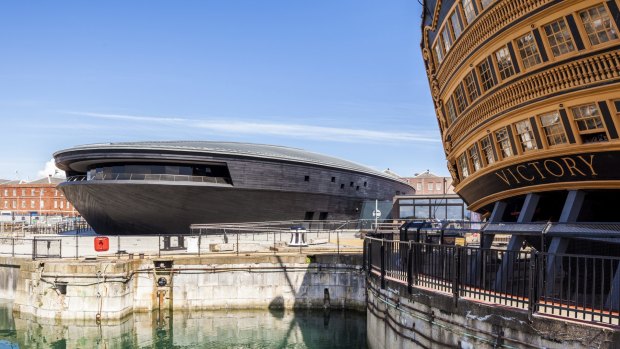
The museum building housing the Mary Rose with another famous warship, the HMS Victory, in the foreground.
A time machine sits on the waterfront in Portsmouth: a sleek, ovoid flying-saucer set among the harbour's oblong warehouses. Step inside and you're transported back 500 years, straight into the bowels of a Tudor ship. Not any old ship either, but the Mary Rose, famous flagship of Henry VIII's navy, with five decks of oaken power and 19,000 recovered artefacts. This is a British version of Pompeii, filled with pewter mugs and leather shoes, discarded cherry stones and beef bones, shoe buckles, loose change and silk ribbon for edging uniforms. All Tudor life is here, and death too. Displays include a skeleton dog, human skulls and the bones of an archer who suffered from an arthritic elbow and had trauma to his hip.
The Mary Rose is the only surviving 16th-century warship on display. It sank in 1545, taking to the bottom its entire contents and all but a handful of its 700 crew, who drowned because the decks were draped in anti-boarding nets. Marine archaeologists hunted for it in the murky silt off Portsmouth in southern England for six years, finally locating it in 1971. It took even longer to salvage. The surviving half of the fabulous warship was raised to great patriotic fanfare in 1982, perhaps not coincidentally the year of the Falklands War.
There's much that makes the Mary Rose special. Many consider its launch marks the founding of a serious English (and later British) navy. Its clinker design was revolutionary and it has the only surviving 16th-century crow's nest anywhere. It has revealed endless information about naval design, since no official ship plans remain from the Tudors, who simply adapted ships to the available timbers as building progressed. The Mary Rose also has a great back story: a successful fighting ship for three decades, whose sudden capsizing on a calm day in Portsmouth harbour remains largely unexplained. It helps that the ship's life ran almost concurrent with Henry VIII's reign, that absorbing era of beheadings, political manoeuvring and heaving bodices so beloved of novelists and movie makers.
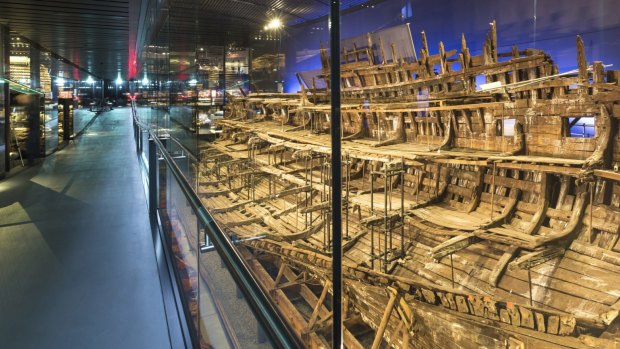
The upper museum gallery looking onto the Mary Rose.
There has long been a Mary Rose museum on Portsmouth's still-functioning naval dockyards, but the ship was previously draped in ducting and dehumidifiers like outlandish Christmas decorations. New preservation techniques have carefully sucked 300 tons of water out of the ship's planking during the past three years, allowing all the modern intrusions to be removed and the ship's structure and detailing revealed as never before.
No clutter distracts from the elegant interlocked puzzle of its timber design. Because the ship curves outwards, you get a close-up look at its lower levels, and so although it sits behind glazing, visitors are close enough to see knots and pegs in the wood. Upstairs, even the glazing is removed. You enter a open platform through air locks (humidity is a constant challenge), leaving nothing between viewers and the mighty wooden structure. It's a half-ship exposed like a matchstick model, all its decks revealed from hold to forecastle.
In short, the just-reopened, revamped version of the museum is almost entirely new, and uses every latest advancement in technology not just to preserve the ship but to provide an updated visitor experience as interactive as it can be amid these delicate relics. Ship's rigging creaks and seagulls cry. CGI video projects 40-second vignettes of Tudor shipboard life using characters dressed in historic costumes: a somewhat eerie movement of flickering figures, like ghosts returned to the ship for a haunting.
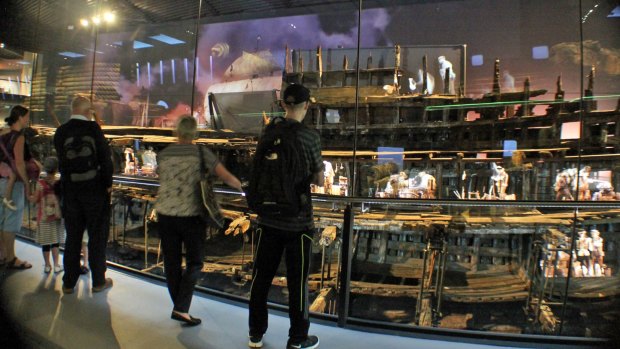
Visitors can see CGI characters animating the decks of the Mary Rose.
If you're in a hurry, you could get a basic overview in about 90 minutes, but you're likely to be longer and, given the other attractions of the historic dockyards, should ideally set aside a full day. An encyclopaedia's worth of information boards explains the artefacts and Tudor life, and very knowledgable volunteers are easy to engage in conversation. There's plenty to ask about, because the ship's contents provide the world's finest collection of Tudor artefacts. Items include a huge collection of pewter, early fiddles and a still-shawm, an oboe-like wind instrument that historians previously thought was invented a half-century later. So, too, the gimbal compass once thought to post-date the Tudor period, yet now sitting smugly among other assorted navigational equipment.
Nine galleries display the artefacts in a clever arrangement that never has you out of sight of the ship itself. Everything is authentic, bar some Perspex additions that provide the outlines of missing materials such as knife handles. For the layman, the artefacts are more entrancing than the ship. Everyday objects include a backgammon set, trousers, purses and a bowl carved with its owner's name (Mycoop). Even aglets (shoelace ends) have been rescued from the seabed. Many of the objects are in remarkable condition, including a clothes-filled officer's chest and his inkwell and candle snuffer. A medical chest is complete with ointments and ear scoops. The barber-surgeon's fingerprints can clearly be seen on the glass medical jars.
There's a pleasing humanity to the displays not often encountered in museums. The ship's crew members are a constant, hovering presence, mentioned by name where known. Some of their remains reveal absorbing details about Tudor health. Archers' skeletons show curvature of the spine, no surprise after you've tried (probably unsuccessfully) to pull the replica English longbow. Beside the bones, an intact archer's kit includes an arm brace and spare bowstrings, as well as personal items such as a nit comb, jerkin and pomander.
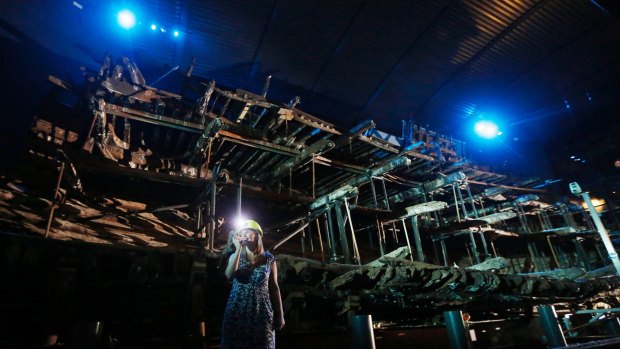
Head of Conservation Eleanor Schofield in front of the hull of Henry VIII's warship, the Mary Rose.
One of the crew's skeletons was found on the orlop deck, surrounded by carpenter's tools. He was in his late thirties, 172-centimetres tall, strong and muscular, but he had arthritis in his spine and ribs, bad teeth and an abscess in his upper jaw that probably prevented him from chewing on his right side. His face has been recreated from his skull and stares out at passing visitors, a fitting reminder of the human tragedy of this great ship's sinking.
TRIP NOTES
MORE INFORMATION
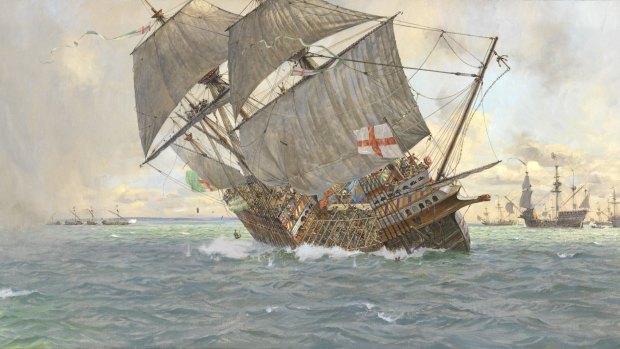
An artist's impression of the sinking of the Mary Rose.Credit: Mary Rose Trust
GETTING THERE
Cathay Pacific flies from Sydney and Melbourne (9 hr) to Hong Kong with onward daily connections to London (13.5 hr). Phone 131 747, see cathaypacific.com.au
SEEING THERE
Mary Rose is displayed at the Portsmouth Historic Dockyard, which covers the 800-year history of England and Britain's naval power. Among its historic ships are Admiral Nelson's HMS Victory (1759) and HMS Warrior (1859), in its day the world's most powerful battleship. Recent addition HMS M.33 (1915) is the only survivor of the Gallipoli campaign. See historicdockyard.co.uk
Brian Johnston was a guest of Visit Britain.
Sign up for the Traveller Deals newsletter
Get exclusive travel deals delivered straight to your inbox. Sign up now.